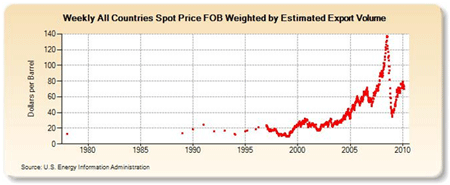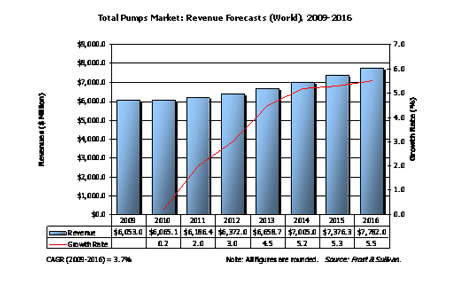The global oil and gas industry has resembled a proverbial roller coaster in the last six years. In an industry that typically cycles, the peaks and valleys in this timeframe seem more pronounced as the world has faced supply and demand challenges, as well as an unprecedented global recession.
The crude oil price spike that occurred in 2008 (shown in Figure 1) had numerous ramifications for everything from consumer budgets to political policy to a boost for alternative fuel solutions and conservation. As one of the major user verticals for pumps, this industry can produce flush or lean times for pump manufacturers. In this article, we explore the expected forecast for pump revenues in the global oil and gas industry, as well as some of the major trends and issues expected to affect pump demand in the near future.

Global Pump Forecast
In 2009, pump revenues in the global oil and gas industry were estimated to be slightly more than $6 billion. As shown in Figure 2, the global market as a whole is in a relatively flat period, and is expected to gradually recover to more "normal" growth rates by the end of the forecast period (2016).

Growth is naturally expected to vary by world region, with North America and Europe expected to grow at a notably slower pace than Asia and portions of South America during this timeframe. Growth is expected to vary within the sub-segments of upstream, midstream and downstream. For the last couple of years (and currently), the upstream segment has generally been strongest as the refinery slice of the business has been hit hard with sagging demand related to more effective efforts at energy conservation and alternative fuels, especially in North America and Europe. Upstream is expected to continue to be strong, with refining increasing gradually during the next three to four years.
Key Trends and Issues
A number of top level trends are expected to affect pump demand in this industry over the forecast period, including the following positive trends:
- The oil and gas sector is expected to be one of the early adopters of intelligent pumping solutions. As exploration moves to more challenging scenarios (subsea, oil sands, etc.), intelligent pump systems can contribute significantly to reduction of operating costs and monitoring of equipment in remote/severe applications.
- The discovery of new reserves (such as Tupi off of Brazil)
- Increased demand for oil/petroleum products in key growth markets (Asia, Middle East, BRIC)
- Continued investment in subsea exploration and development
- Environmental compliance and energy efficiency are expected to be top priorities in this end-user space, facilitating adoption of advanced pump technologies
- Regional trepidations about the level of oil import dependence could factor into increased activities through the oil and gas stream
There are, of course, also challenges in the industry that help create the volatility in the space, including:
- Political instability and terrorism in key production countries
- Politically/economically instigated actions by oil cartels
- Lingering global economic weakness
- Maturing of oil fields in general, along with a global realization that oil is a finite resource
- Conservation and alternative energy efforts
This last point is a bit of a "wild card" in the equation, and deserves a closer look.
Conservation and Alternative Fuels
A good deal of investment in these efforts rests on the price of oil. Current price per barrel levels do not justify investment in some key alternative options, including biofuels (such as ethanol) and oil sands. However, prices could change dramatically, reinvigorating efforts in alternative fuel developments. A number of key points include:
- In recent years, global interests on climate change and environmental protection have been high. This resulted in the advent of alternative energy fuels, which are expected to be increasingly used to meet energy demands in the future.
- Among non-conventional sources of energy, bio-ethanol and bio-diesel have recently gained prominence. Condemned by many ecologists, emphasis has been laid on third generation biofuels that are expected to decline the demand of conventional sources of energy over the long term.
- Government regulations focused on improving environmental standards by reducing emission of greenhouse gases, coupled with the drive to achieve Kyoto emission targets by participating nations are expected to encourage a slow shift from conventional energy to renewable energy resources.
- With a large number of automobile manufacturers working toward producing cleaner hybrid cars, demand for conventional energy is reduced.
Although all these factors are posing a threat to the demand side of conventional energy sources, the current demand levels cannot be met by non-conventional resources. This portends oil energy dominance for some time. It is a matter of time, however, before the supply-demand-resource availability equation factors more heavily toward alternative fuels for a variety of reasons, not the least of which will be much higher, permanent oil prices. Therefore, we witness key market major pump suppliers keenly focused on a wide variety of current and potential oil fuel alternatives.
Although the overall nature of the global oil and gas industry (volatility) is not expected to change, this will continue to be an area of opportunity for pump suppliers. The challenge will be to understand the timing of key trends (by region, by industry segment, by application) that will signal more severe swings in the future.
Pumps and Systems, April 2010


